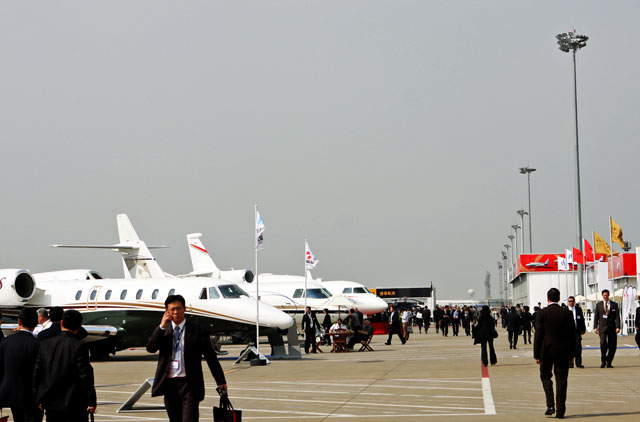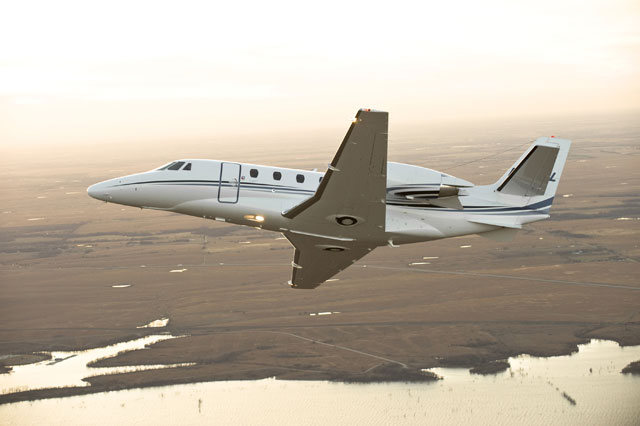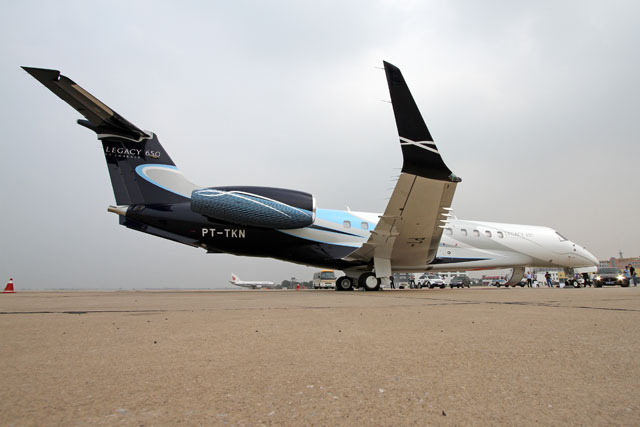Buoyant demand for business jets, coupled with growth potential in the lucrative large-cabin, long-range market, ensures China remains one of the most important markets in the world.
This is reflected in the growing popularity of the Asian Business Aviation Conference and Exhibition (ABACE), which takes place this year from 16-18 April at the Shanghai Hawker Pacific Business Aviation Service Centre. About 150 exhibitors, including the major western manufacturers and a growing number of Asian suppliers, will be present.
Honeywell says about 34% of the Asian aircraft operators are interested in new purchases. Fleets have been growing at double-digit rates throughout the past five years, adds the company in its latest annual report and forecast.
 |
|---|
| ABACE About 150 exhibitors will be at ABACE this year |
Southeast Asia, Australia and Hong Kong are traditionally strong business aviation markets in the region, and while India continues to lag behind because of regulatory restrictions and ongoing infrastructure woes, corporate aircraft have caught on far more quickly in China.
This is driven by corporations and the fast-growing number of high-net-worth individuals, with both groups wanting the convenience provided by business jets. Tracking the number of aircraft in China has not been easy but Asian Sky Group, a Hong Kong-based consultancy which provides a range of business aviation services to clients in Asia, has produced a survey it will publish at ABACE.
It estimates 336 business jets were based in Greater China at the end of 2012, with 57% in China and 33% in Hong Kong. This was an increase of 40%, or 96 aircraft, from 2011, with 91% of that in the large, super-large, ultra-long-range and corporate airliner categories.
Mainland China itself added 60 aircraft in 2012, up 40%, although the growth rate is lower than the 45% in 2011. While growth rate has been slowly declining, this is only because the market is maturing.
"There is still great potential in China - absolutely - and the growth rate is the highest for Asia," says Jeff Lowe, general manager of Asian Sky Group. "China is a large-cabin-and-up market, where Gulfstream and Bombardier are the dominant players. Falcon and Embraer's market share is growing faster at the expense of Cessna and Hawker Beechcraft."
Chris Buchholz, chief executive of Hongkong Jet, points out the impressive growth comes from a low base. And while "several hundred more aircraft" will be added to the region by the end of the decade, the size of the market will still be "significantly smaller" than that in the USA.
Buchholz, whose company provides aircraft management, maintenance and charter services, says there are several reasons behind the demand for larger aircraft: "Firstly, the handling costs are high compared with other parts of the world. Therefore, using a small jet will not give the customers the full benefit of lower cost since landing fees, handling fees and other user fees are very high in the region.
GREAT EXPECTATIONS
"Secondly, the expectation of cabin comfort is very different in China. The new customers expect a stand-up cabin with five-star service as they are new to business aviation. A full white-linen, silverware, three-course dining experience is expected. To accommodate the catering choices, it can only be done with a sufficiently large galley, which is in a super-midsize or ultra-long-haul aircraft."
Aircraft sales, while buoyant, could be hit by the Chinese political leadership's attempt to introduce a measure of austerity among high-profile individuals amid a growing income gap in the country. There is also uncertainty about import taxes and value added taxes on business jets, with some speculating they could be doubled. Restrictions on China's airspace leads to delays at all airports and more secondary airports capable of handling business jets are needed. A relaxation of access to low-altitude airspace would also enable flight schools to address a pilot shortage. Various regulatory issues also hinder operations.
"If China were to reduce time for permit applications and reduce some of the handling costs, such as government fees, it would result in a lot more activity in China," says Buchholz.
"If a level playing field can be applied to foreign-registered aircraft in terms of lower handling cost and better access to remote airports, more investment and trade will be seen, since business-jet users exert very significant investment and trade influence," he adds. "Regarding mainland-registered aircraft, speeding up the time taken for mainland registration will greatly help address the ongoing growth."
 |
|---|
| Cessna Dassault and Embraer are eating into the market share of Cessna and its Citation series |
Some airframers are setting up assembly plants in China to overcome high import costs. Embraer is converting its ERJ145 manufacturing facility at Harbin in the northeastern Heilongjiang province into a Legacy 650 plant that will initially produce six aircraft - eventually 20 - per year.
Just before ABACE 2012, Cessna signed a joint-venture agreement with China's state-owned airframer AVIC to manufacture and certificate a range of business jets, utility single-engined turboprops and single-engined piston aircraft in the country. They will also jointly develop new models for the market. Other companies, however, do not believe it is necessary to go down that road.
Market leader Gulfstream, which says its customers operate 106 aircraft in China and Hong Kong, believes in its focus on "having the right people, parts and service facilities in place".
OPERATOR SUPPORT
"Where the aircraft is manufactured isn't nearly as important as where the aircraft goes after it's manufactured. Our primary focus continues to be ensuring we have the best support available to our operators," says the company.
Bombardier, which has more than 92 aircraft registered in Greater China, says its "alliances on the commercial aircraft side of the business" help.
"Traditionally we've been selling larger aircraft in China, such as our Global aircraft. However, in the past few years there has been increasing demand for small and medium jets as well, such as our Challenger and Lear jet aircraft," says the company. "Our edge in China stems from our strong sales team and our large product portfolio of aircraft."
China wants to get in on the act itself. AVIC wants to produce a range of aircraft, initially in partnership with the likes of Cessna and Embraer and eventually on its own. This will initially go to domestic demand and, gradually, international markets - just like its military and commercial aircraft.
"We can't only allow Western companies to sell aircraft in China. We want this business too," Wang Yawei, president of AVIC's business aviation division, AVIC Aviation Techniques, told Flight International in November 2012.
He added that "AVIC has the mandate to manufacture several types of business jets" and "establish its presence" as China has in the automobile business. "The rapid development of China's economy has resulted in a boom in business aviation here, and we want to be competitive in the global market too."
 |
|---|
| AirTeamImages Embraer is converting its ERJ145 facility at Harbin into a Legacy 650 plant |
The greater availability of business aircraft maintenance and repair shops has boosted this demand, with more facilities opening in bigger cities such as Beijing, Shanghai and Hong Kong. More spare parts are being placed in Asia, with Gulfstream saying it has parts worth more than $56 million in distribution hubs in Beijing, Hong Kong and Singapore. With more field service representatives in the region, operators get help much faster. Costs, however, remain an issue.
"Considering a heavy check can take several weeks, the client may not be able to get a spot that long because of the limited space in Beijing, Shanghai and Hong Kong. Even if space is available, the daily rate will be very high, so the maintenance costs for a heavy check will be prohibitive. Therefore, the market needs more maintenance MROs at low-cost airports with maintenance-dedicated hangars," says Buchholz.
Operating fees remain high and approval processes still take a long time, which is unlikely to change in the near term, says Lowe: "For China, the compensation fees for foreign operators and the flight permit application process is certainly curtailing business. Likewise, the importation and AOC approval processes are curtailing business."
GROWTH LEVERS
He adds that none of this will change in the immediate future as these items "remain levers" with which the Civil Aviation Administration of China "can control the growth of business aviation" in the country.
Despite the challenges and restrictions, the growing demand for aircraft means there is greater demand for better management and charter services.
"One interesting trend in China is that high-net-worth individuals are rapidly becoming more sophisticated. It is very important for aircraft operators in China to be aware of this and make sure their operational excellence and service excellence can keep up with the VIP clienteles' discerning needs," says Buchholz.
Lowe believes the market is opening up to established western firms such as VistaJet in the charter segment and Comlux for management. More will come, given the buoyant demand.
"There is such a rich vein of emerging wealth in China that if one buyer pauses, a new one pops up someplace else," says Lowe.
Source: Flight International























